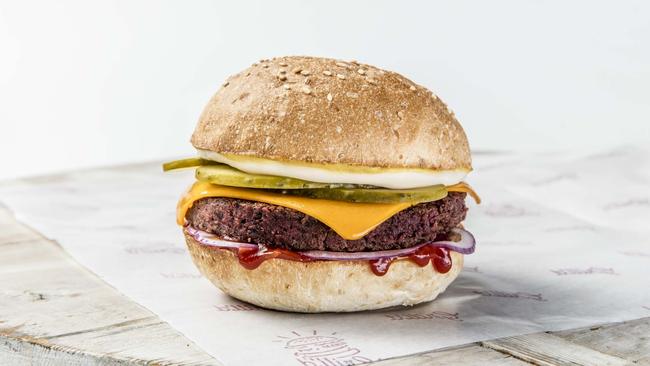Plant-based meat alternatives are not a niche, according to developers
PLANT-BASED alternatives are now mirroring meat characteristics and winning over more consumers, writes NICOLA BELL.

ACCORDING to its developers, plant-based “meat” is not a niche and the current reliance on animal protein is not sustainable.
So says Impossible Foods, whose mission is to eliminate the need for animals in the food system by 2035.
And while those who produce and consume red meat disagree that animal proteins need to be eliminated, Impossible Foods has created the Impossible Burger, a plant-based protein that looks, tastes and smells like meat.
CHARGED LAID OVER ‘GIPPY GOAT’ THEFT
SUPERMARKET GIANTS SLAPPED DOWN
SALEYARDS DIRECTOR THREATENS JOURNALIST
The burger is now available in more than 4000 restaurants — up from about 40 restaurants 12 months ago — across the United States, Hong Kong and Macau, with plans to expand globally.
The Impossible Burger is made mostly of water, wheat and potato proteins, coconut oil, and heme.
Impossible Foods chief science officer David Lipman said the plant proteins give the burger its texture, the flavour comes from heme and the fat and sizzle comes from deodorised coconut oil.

“Plant-based meat is not a niche. It’s quickly becoming a significant food category simply because our current reliance on animal-based meat is not sustainable.”
In fact, Mr Lipman said the only competition for the Impossible Burger was animal-based meat.
“We didn’t make the Impossible Burger for people who eat a plant-based diet,” he said.
“Our target consumers are people who eat and love meat from animals.”
Mr Lipman believes the Impossible Burger is more sustainable and healthier than animal meat.
“Because it’s made entirely from plants, the Impossible Burger is free of cholesterol, hormones, antibiotics, artificial ingredients or slaughterhouse contaminants,” Mr Lipman said.
Impossible Foods claims the burger uses 75 per cent less water, emits 87 per cent less greenhouse gas, and uses 95 per cent less land than a conventional beef burger.
DOLLAR DIP A WINDFALL FOR MANY
MOOD SOURS AT MELBOURNE MARKETS
PRODUCERS TOAST NEW CHINA AND KOREA DEALS
But the Impossible Burger isn’t the only plant-based protein trying to appeal to meat eaters and flexitarians (people who claim to be vegetarians but eat small amounts of red meat).
The plant-based Beyond Burger patty, which is now available in Australian supermarkets, is made from peas but looks red because of the use of beets.
According to the Beyond Meat fact sheet they “wanted to keep the whole experience of cooking a burger as similar as possible” for flexitarians, so they have created a burger that changes colour as it is cooked, just like animal protein.
The burger chain Grill’d has also developed a plant-based meat patty this year, with the Vegan Cheeseburger, designed to look and taste like a real beef cheeseburger with ingredients such as pea protein, chick peas and beetroot powder.
A Grill’d Australia spokeswoman said there was a growing trend of people reducing their intake of red meat and choosing to eat more plant-based options.
“The biggest increase is coming from flexitarians,” the spokeswoman said.
Meat and Livestock Australia’s chief marketing officer Lisa Sharp said since 1985 there have been plant-based proteins available that aim to “replicate meat” but what has changed is the “considerable improvement in taste, texture and marketing”.
Ms Sharp said MLA research had found while consumers might not consider themselves vegetarians they wanted variety.
“They still enjoy red meat but for cost reasons and health they seek variety,” she said.
Ms Sharp said while red meat will always have competitors the risk is “sometimes they change their game”.
“Consumers told us what they don’t like much is highly processed food, so for the Impossible Burger and synthetic cellular meats, their real strength is on animal welfare and environmental claims, but that trend around natural and unprocessed, is our (red meat’s) strength.”
Another consumer strength for beef and lamb was the fact they were in the Australian Dietary Guidelines due to their macro nutrient benefits, Ms Sharp said.
Monash Food Innovation Centre chief executive Angeline Achariya agreed consumers were looking for meat alternatives.
Dr Achariya said while there would always be demand for red meat, the consumer trends were shifting.
“Millennials are now the biggest consumers and they are conscious about sustainability. These alternatives are still at a premium, but millennials will spend money on things they see value in,” she said.

HEME THE MAGIC INGREDIENT
WHAT sets the Impossible Burger apart from other plant-based proteins is heme.
Heme is an iron-containing molecule that occurs naturally in every cell of animals and plants.
Impossible Foods chief science officer David Lipman said “you can’t make meat without heme”.
Heme is the molecule that carries oxygen in the blood, but is also a critical part of the system every cell uses to burn calories from food to produce the energy that keeps us alive. Heme is abundant in animal muscle, and this is what gives meat its taste.
“The magic ingredient responsible for the unique flavours and aromas of meat is heme,” Mr Lipman said.
Impossible Foods set about developing a scalable way to make heme without animals and found by adding a plant gene to yeast cells, they could use fermentation to produce a heme protein naturally found in plants, called leghemoglobin.
“The heme in the Impossible Burger comes from the roots of a soy plant, and is attached to the protein leghemoglobin,” Mr Lipman said.
It’s this key ingredient that makes the Impossible Burger taste like meat.
“When the heme in the Impossible Burger is combined with other elements found in meat — vitamins, amino acids, and sugars — and heated up, it generates flavour that our taste buds and brain recognise as meat,” Mr Lipman said.
Monash Food Innovation Centre chief executive Angeline Achariya has tried the Impossible Burger and said she was “pleasantly surprised”.
“With the heme and the texture, with the bun, and all the other things, it tastes great,” Dr Achariya said.


